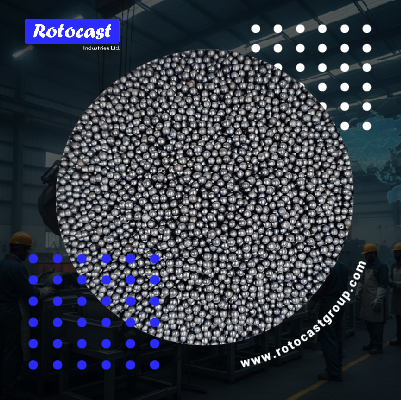
Inside the Process: What “Global-Quality” Really Means
1) Clean Steel Chemistry = Fewer Breakages
Global-quality Steel Shot and Steel Grit start with controlled low-phosphorus and low-sulfur steel for toughness and fracture resistance. Tight ladle metallurgy, deoxidation, and inclusion control produce a refined microstructure. Result: media that retains shape longer, delivers repeatable Ra, and reduces dust‐collector load.
Why it matters:
- Lower consumption rate per m² blasted
- Fewer screen recharges and cyclone cleanouts
- Stable Almen intensity/roughness over long runs
2) Atomizing & Quenching for Core Toughness 
Molten steel is atomized to form spherical shot, then rapidly quenched to lock in hardness potential. For Steel Grit, crushed shot is subsequently shaped to angular profiles (G25, G40, etc.). Precise quench parameters prevent brittleness, reducing media shatter in high-energy wheels or air blast.
Use cases:
- Shot peening for fatigue life improvement
- Architectural steel prep for coatings adhesion
- Foundry desanding/deflashing without substrate damage
3) Tempering to the Right Working Hardness
Post-quench tempering tunes hardness bands (e.g., 40–51 HRC for cleaning; 50–60 HRC for aggressive scale removal). Correct tempering balances cutting action and durability, minimizing media attrition and keeping finish within spec.
Benefits:
- Predictable profile with fewer passes
- Optimal balance for mixed substrates (cast iron, mild steel, alloy steel)
- Lower total cost per blasted ton
4) Multi-Stage Screening & Shape Control
Global-quality media is screened through calibrated meshes to maintain narrow size distributions (S230, S330, S390, etc.). Sphericity (for shot) and angle retention (for grit) are monitored to ensure consistent impact energy and coverage.
What to look for:
- Tight size tolerance (reduced “fines” and oversize)
- High roundness index for shot; controlled angularity for grit
- Batch traceability on every bag/drum
5) Compliance with International Standards
A truly global product aligns with widely recognized norms such as ISO 11124/11125 (metallic abrasives), SAE J827 (cast steel shot), and AMS 2431 (aerospace peening media). Certificates of Analysis (CoA) accompany each lot, summarizing hardness, size distribution, density, and microstructure.
Outcome on the floor:
- Faster qualification and PPAP acceptance
- Fewer vendor NCRs and hold-tags
- Easier multi-plant/global sourcing alignment
6) Process Analytics & In-Lab Testing
Modern Indian manufacturers instrument every step—chemistry, hardness, microstructure, density, and micro-cleanliness—using spectrometers, Rockwell testers, metallographic labs, and durability tests (e.g., cycles to breakdown).
Industrial insight:
Plants that chart attrition rate vs. wheel speed can help you set blast parameters that cut media consumption by 10–20% while maintaining the same Ra.
7) Packaging, Logistics, and Global Readiness
Moisture-barrier packaging, pallet stability, and export-grade documentation keep product dry and traceable across sea routes. Predictable lead times, safety stocks, and INCOTERMS clarity matter just as much as metallurgy.
Where Rotocast fits:
Rotocast combines BIS-compliant steelmaking with ISO-aligned QA, delivering Steel Shots and Steel Grits that meet international specifications while keeping TCO competitive for foundries and fabricators worldwide.
Steel Shot vs. Steel Grit: Quick Comparison
-
Steel Shot (spherical):
-
Best for peening, general cleaning, and maintaining dimensional accuracy
-
Produces uniform, lower surface profile; ideal for coating prep without over-etching
-
-
Steel Grit (angular):
-
Faster scale/rust removal and deeper anchor profile
-
Preferred for heavy mill scale, flame-cut edges, and aggressive cleaning prior to metallizing
-
Real-World Applications
- Foundries: desanding/deflashing castings, cleaning heat-treated parts
- Shipyards & Oil/Gas: large-area surface prep for high-build coatings
- Automotive & Aerospace: shot peening springs/gears to extend fatigue life
- Fabrication & Construction: coating prep on beams, plates, and bridges
- Steel Casting Foundry: consistent finish before machining and NDT
Selecting the Right Media for Your Job
Checklist:
- Substrate & desired Ra/profile
- Target throughput and blast intensity
- Wheel/air-blast machine specs and reclaim system
- Hardness band vs. life/cutting trade-off
- Compliance needs (ISO/SAE/AMS) and CoA availability
A capable Steel Abrasives Manufacturer will help optimize size mix and operating mix—often the biggest lever for cost/consumption reduction.
Ready to lower abrasive consumption and stabilize finish quality? Explore Rotocast’s full range of steel abrasives and casting solutions or request a product quote today.

